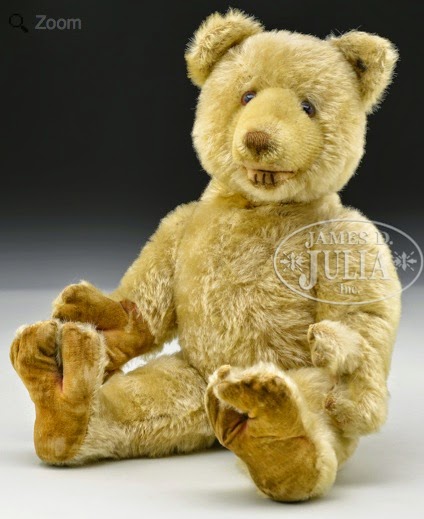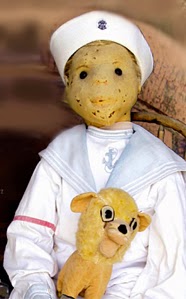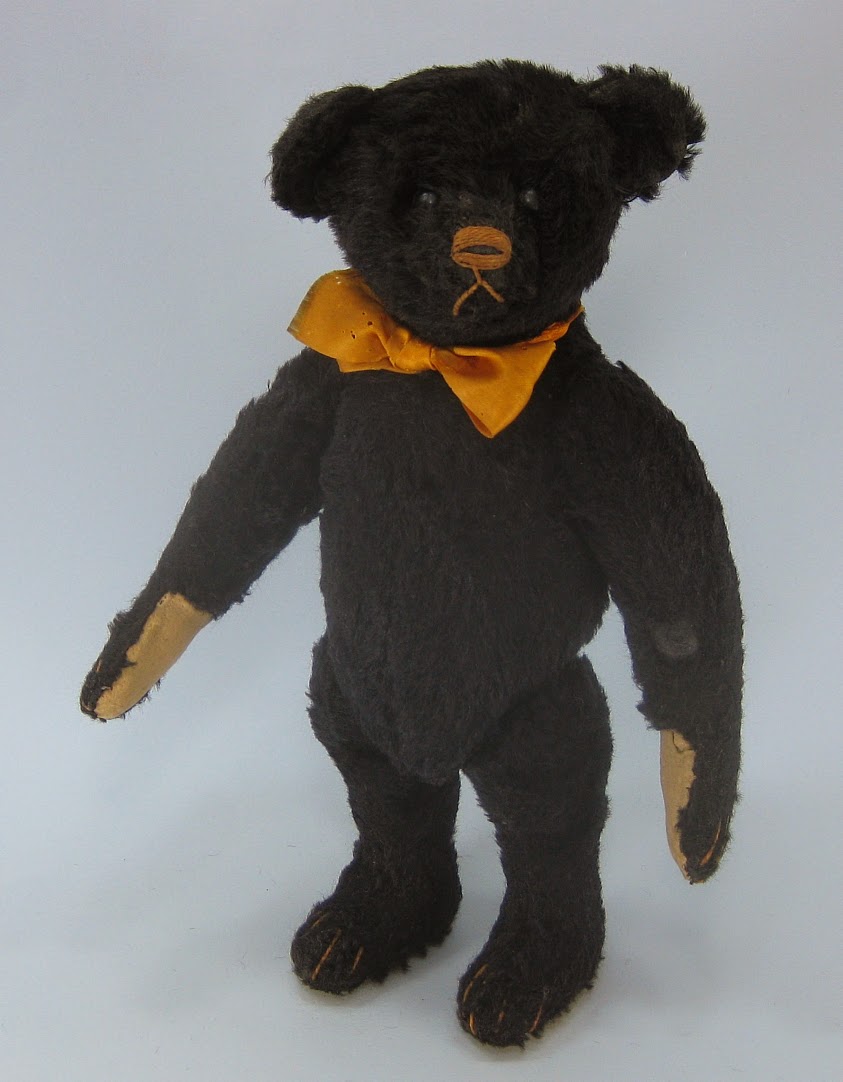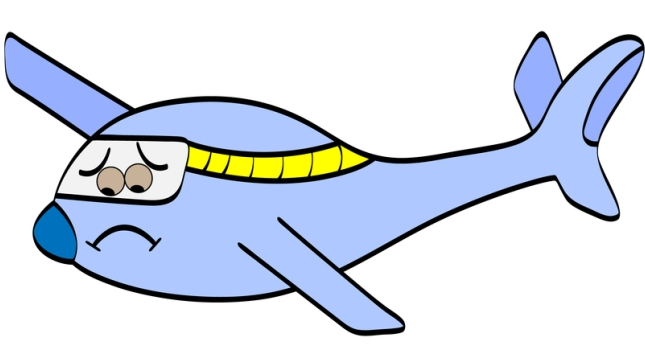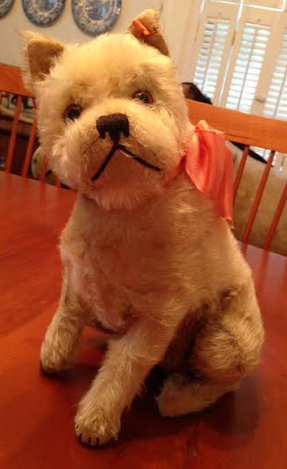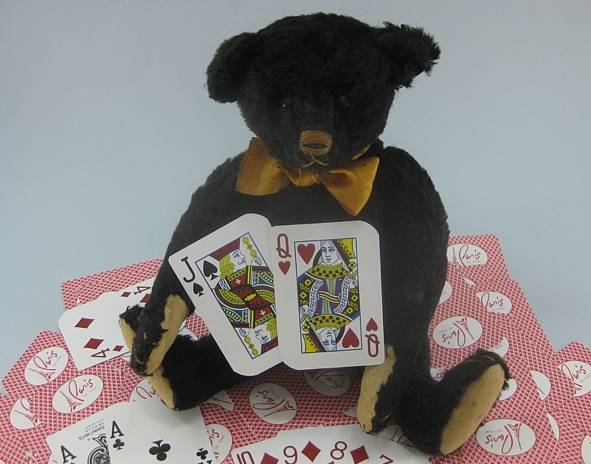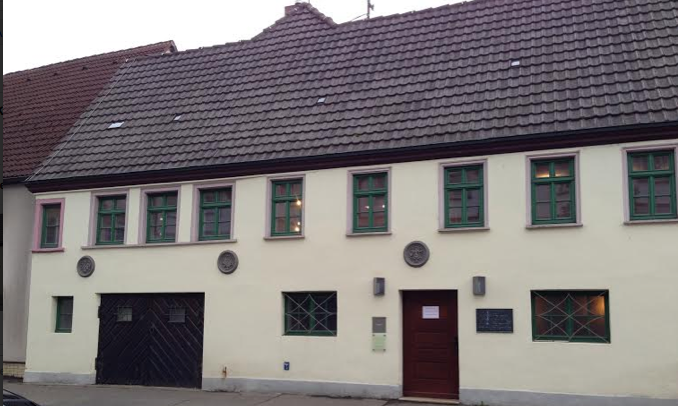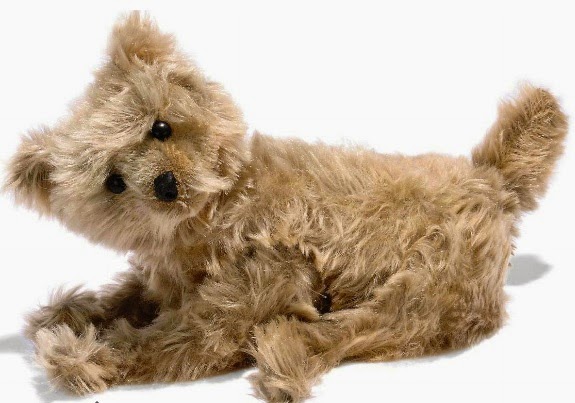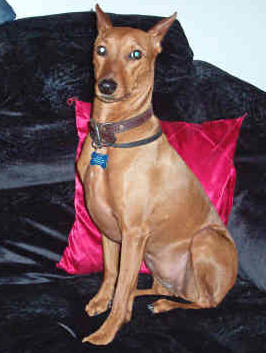Have you ever watched a TV show where a regular person has literally "hit the jackpot" with an amazing boot sale, flea market, or auction find? Well, this doesn't occur in reality very often! However, it did happen in the most Steiff-like way to a terrific and lucky lady recently, who just happened to place the right bid at the right time on the right auction lot. Here is an interview with her about this spectacular find; this conversation was first published in the Spring, 2014 Steiff Club magazine. Steiffgal: Josie, thank you so much for speaking with us today! Could you please tell us a bit about yourself?
Josie: My name is Josie Rockett, and I live with my family in Rye, in the South East of England. I am a full time Mummy to my three young children and most of my time is spent looking after them, our two dogs, and running our home.
Steiffgal: Are you a Steiff collector?
Josie: I am a collector of vintage and antique Teddy bears. Our hug is fairly small and mostly consists of British bears; we actually only have a couple of Steiff bears in our collection.
Steiffgal: You had a very exciting find at auction recently. Can you give us some background on that?
Josie: I wasn't at the auction when I won the lot; it was an incredibly lucky twist of fate. I spotted a lot at a general auction being held at an auction house, there was no photograph, only a description. I liked the sound of it, took my chances, and placed a bid remotely. I was very happy to win the lot and my Father, who lives close to the auction house, went to collect it for me.
Steiffgal: Your auction win turned out to be much more than you expected. Tell us about opening up the old trunk and what you were thinking as you were going through its contents.
Josie: Nothing could have prepared me for what I was about to find. A week after the auction my Father came to visit us. On arrival he handed me an old red suitcase. As I opened the case, the first thing I saw were some dolls, some doll clothes, and some lovely Teddies. Then saw something wrapped in a blanket at the bottom of the case. I picked it up and started to unravel the blanket. The first thing I saw was a black mohair paw. I then very slowly lifted the blanket off completely to find a beautiful black antique Teddy! My heart was pounding, I cannot tell you the excitement and joy that then erupted in our house! Had I just found an antique black Steiff bear?
Steiffgal: That is a fantasy situation that every Steiff collector dreams of! How did you know you might have a special treasure?
Josie: My first feeling was that he may be a Steiff bear from the moment I saw him. His shape and line and beautiful expression led me to feel that he could be a Steiff. After an excited sleepless night, I got up the next morning, took some photographs, and sent them to off to Steiffgal.She confirmed that she too thought he was an early black Steiff bear. Based on where I was located, and what I had found, she suggested I contact Carsten Esser at TeddyDorado auction house about the bear.
Steiffgal: You did take the bear Germany to meet Mr. Esser. Tell us about this trip.
Josie: The trip to Germany was amazing! My Father came with me and we had such an adventure. Meeting with Carsten was wonderful; I was quite nervous but very excited. It was a little nail biting watching him examine the bear, but he did it with a smile and it wasn't long before we were all very excited! The next step was for the bear to go to Giengen for authentication, as he didn't have any Steiff IDs on him. It felt good to leaving the bear with Carsten. Up until that point I felt like I had been his guardian. There was a little sadness but an overwhelming feeling of relief and happiness that he was in such safe hands.
Steiffgal: You named the bear "Black Jack." Can you tell us how that name came about?
Josie: The name Black Jack was really given to him because he is a black Teddy bear. It is also quite lovely that my late Grandfather was called Jack. Both my brother and I were given names that started with a "J" as a tribute to him, so it is very special for him to have the name Jack.
Steiffgal: How did you decide whether to keep the bear or sell him at auction?
Josie: This was a very difficult decision. We did consider keeping Jack but after giving it a lot of thought we decided that he would be most at home in a fine Steiff collection or museum where he could be properly enjoyed. Our house is full of children and pets and in the short time I had him, he was wrapped up and hidden away for safety. If he were to stay with us, he would remain this way. I don't believe he wants to be hidden away anymore. And I thought that the very best place for selling him would be through TeddyDorado at the 2014 Steiff Sommer Festival Auction, given that this event attracts the attention of almost every Steiff collector on the planet!
Steiffgal: Jack went through a rigorous process by Mrs. Manuela Fustig, head of the Steiff Archive in Germany, in order to be authenticated as Steiff. This certificate is pictured here for the readers to see. What went through your head when you learned that he received this certification?
Josie: I can't tell you how amazing it was to hear that news, it was so great to be able to say "Black Jack is a Steiff bear!" From the day I found him up until that moment, it all felt like a dream. I think the news just made the whole situation more real for me.
Steiffgal: Will you be going to the Steiff 2014 Summer auction to watch his sale?
Josie: Yes! It will be so lovely to say good-bye to Jack and wish him well for the next part of his journey. I think there is something magical about him coming back to his place of birth to find his new home. What an adventure he has been on! I have never been to Giengen and I am so looking forward to going. And, if I could tell his new owner one thing, it would be pretty simple. Just love him!
Steiffgal: Josie, thank you so much for sharing this amazing story with us!
Steiffgal: Carsten, what were your thoughts about the bear when you first heard of him?Carsten: The first time I heard about that bear I thought "What a great find" - which I do not think very often as we frequently handle very old and near mint Steiff treasures here at TeddyDorado. Then almost immediately after that I thought "Hopefully he is still in very good shape!" I requested photos, and when I received them, I thought, "Oh dear, he passed that level of examination in a brilliant way!" I wanted to learn more about the bear and do some research on him, so I offered the owner the opportunity to send us the bear as a consignment or at least to get a certificate of origin on him from the Steiff Company. We decided to meet in person about the bear at hotel near the Cologne-Bonn Airport, which is close to our headquarters.
Steiffgal: What was it like to see the bear in the fur for the first time? Carsten: When I first saw the Teddy bear he was wrapped in white silky paper - like fine clothes sometimes are. Then I took the white paper off and my first impression just was "Yes!" and I could not hide a bright smile on my face but I still was saying nothing I think. Then I carefully looked all over the bear, and studied his pattern, face, pads, and seams. He was in very good condition for being over a century old! I tried all his joints, and took a close look at his antique golden taffeta ribbon. I probably studied the bear very intensely for three minutes - and looked at nothing else in the room during this magical period. When I was done with the initial examination, I told the consignors that based on my experience and knowledge, they indeed had an original Steiff Teddy bear made sometimes between 1908 and about 1914 or 1915. I also told the consignors that this bear never had red felt under his eyes, like the famous Steiff Titanic bears, and was probably even rarer than a Titanic bear!Steiffgal: So what happened next? How did you prove the bear was indeed made by Steiff?Carsten: The consignors agreed to leave this bear with me, and I then brought it to the archival experts at Steiff in Giengen. The bear spent the holiday season 2013/14 inside Steiff archives. A few months later, after much research, testing, and evaluation, we finally received the official documentation from Steiff indicating that this bear was authentic and manufactured in 1912.
Steiffgal: So what was it like to receive this great news?Carsten: It was exciting and a great relief, but I always knew in my heart that Black Jack was made by Steiff. To me this Teddy bear is very special and absolutely in a class of its own like the other famous Steiff bears we have auctioned off at TeddyDorado, including Othello and Wistful Happy. It is also incredibly exciting that the Steiff company is creating a replica of Black Jack for their spring 2015 line. This fabulous new collector's piece will debut at the 2014 Steiff Sommer Festival! The speed of this replication and launch is unprecedented, and simply confirms Jack's universal appeal!Steiffgal: And now the last but hardest question. What is Black Jack worth?Carsten: The opening bid is 8,000 euro, but even as the auctioneer, I really do not have any idea what he will sell for in the end. Time will tell, and we will all see what happens. As with other high profile TeddyDorado auctions, there will be many photographers and media in the room when Black Jack goes under the hammer. Everyone is very happy and excited that this magic moment is coming so soon!Steiffgal: Thank you for telling us more about Black Jack, and best of luck at the auction!
Steiffgal hopes that someday you have a Steiff find of a lifetime as well!
Have a question about one of your Steiff treasures? Let's talk! Click here to learn more.





